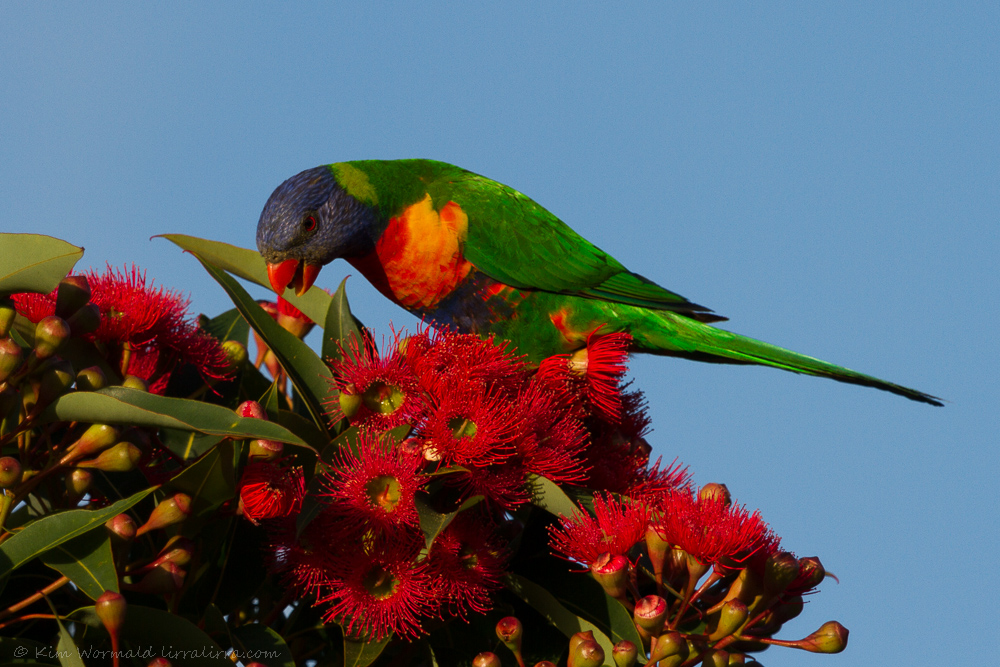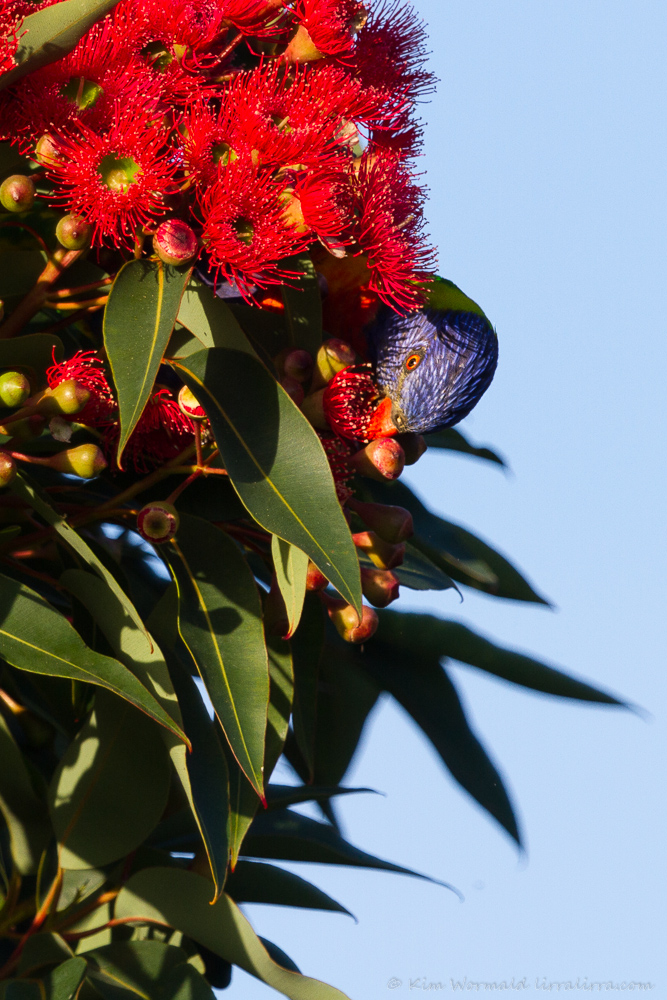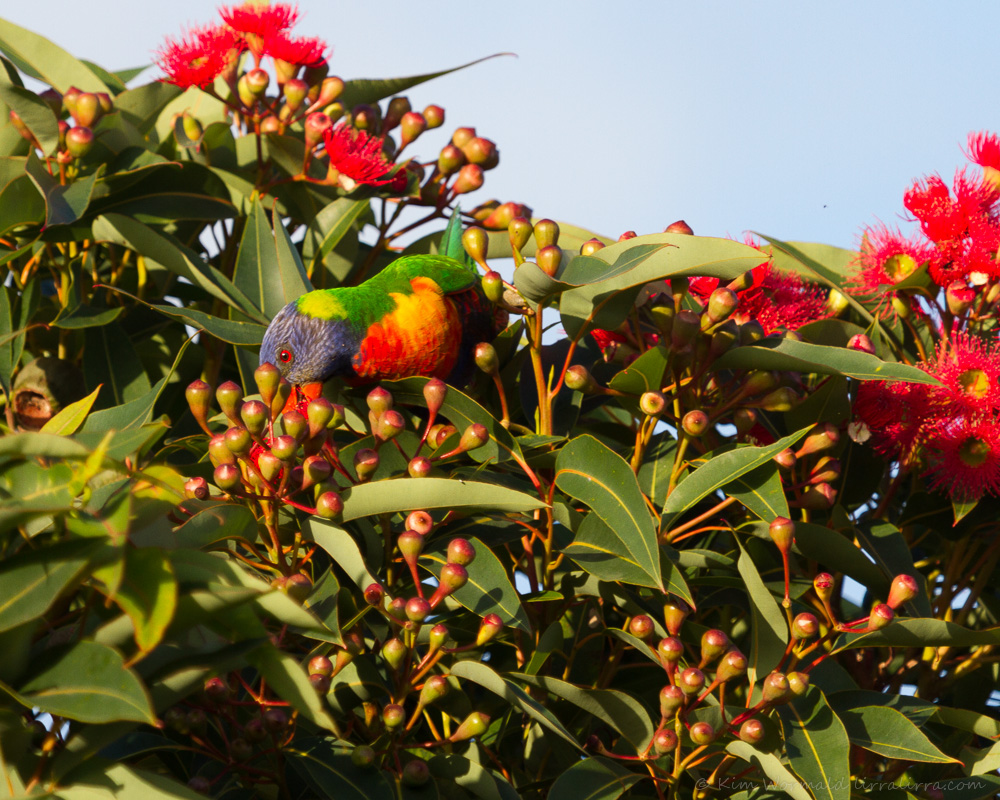It fascinates me that a flock of birds as colourful as Rainbow Lorikeets can fly into a tree and disappear. These images show how their colours blend perfectly with the reds, greens and yellows of a flowering eucalypt.

Rainbow Lorikeet (Trichoglossus haematodus)
Canon 7D, 100-400mm L IS USM, 1/640, f/5.6, ISO 100, focal length 360
The Rainbow Lorikeet is one of Australia’s brightest birds with its purple-blue head and belly, bright red bill, orange-red chest, lime green collar and bright green wings, back and tail. Apart from the purple-blue, which resembles the shadows, this eucalyptus tree shares the rainbow’s colours.
The rainbow’s disruptive colouration makes it difficult to see in this environment as the overall bird shape is replaced by patches of colour.
 Rainbow Lorikeet (Trichoglossus haematodus)
Rainbow Lorikeet (Trichoglossus haematodus)
Canon 7D, 100-400mm L IS USM, 1/500, f5/6, ISO 200, focal length 360mm
“Peek-a-boo!” I am fond of this shot, it makes me smile to see the Rainbow Lorikeet peeking around the blossoms to extract nectar. Highly coloured birds rely on high-energy foods to maintain their bright plumage. Rainbows also eat seeds, fruits and occasionally take insects.
 Rainbow Lorikeet (Trichoglossus haematodus)
Rainbow Lorikeet (Trichoglossus haematodus)
Canon 7D, 100-400mm L IS USM, 1/400, f/5.6, ISO 160, focal length 310mm
I’m interested to see the way the sky looks a different blue in these images. The first image is the most accurate for the day. I attempted to increase the saturation of the sky in the final image but gave up as it looked odd, it whitened the blossom filaments that are outlined against the sky and when I tried to selectively decrease the exposure the patches of sky seen through the foliage were nasty little beasts to track down. There must be a way to increase the blueness of the sky and it’s probably simple – something else to learn one rainy day.
Large flocks of Rainbow Lorikeets screech and chatter when settling down for the night at dusk, making an incredible racket that can even be heard when driving by with the car windows closed. Other rainbow images can be seen in the post called Feathered rainbows.
Happy birding, Kim
.

The Rainbow Lorikeet is a beautiful bird! Your photos are stunning!
Eileen, thank you for your lovely comment, they really are beautiful birds and very well named!
ohhh, it s so beautifull !! colors very intense, great pictures !
well done kim ☺
Thank you Eric, I’m so pleased you liked the lorikeet images 🙂 We’re lucky to have such colourful birds down here.
Kim, these images show well how the Rainbow Lorikeets can seemingly disappear in trees! I adore these beautiful Lories.
Isn’t nature awesome 🙂
Beautiful plummage innit just. I can’t believe how sharp your photos are.
Thank you m’dear! I’m glad you appreciate the sharpness, I love seeing the fine details of the birds.
Yay I can post this week! What cute birds, they really are very well hidden among those blossoms. Lovely photos
Tamsin, I’m really pleased you could comment this week, it’s great to get comments, thank you! It’s pretty amazing how well hidden they are.
Lovely shots! Rainbow Lorikeets have amazing colours. We see them around here occasionally, but mainly just passing through. Maybe the larger parrots scare them off, I’m not sure if there’s some territorial issues between various parrots or not.
~ Joy
Hi Joy, I’m glad you like the images 🙂 Funnily enough it’s the rainbows that are most assertive, they often drive away rosellas and other lorikeets. As beautiful as they are it might be best if they just visit occasionally!